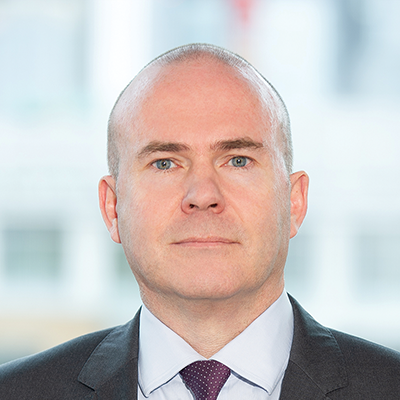High Yield: Halfway There?
To quote the renowned words of Jon Bon Jovi, we’re halfway there (or so it seems).
On the one hand, high yield has regained much ground, albeit amid intermittent bouts of volatility, with the asset price rally that began in the second quarter persisting through much of the third. Companies have continued to successfully raise capital, evidenced by another quarter of elevated issuance—particularly in the U.S. high yield bond market, where issuance surged to a near-record $125 billion.1 And while much of that has been in support of refinancings, there are indications of a growing M&A pipeline, suggesting companies are beginning to once again think longer-term. Default expectations have accordingly remained in moderate territory, down significantly from peak-COVID forecasts.
Although volatility returned at the end of the third quarter, performance was positive during the period, with U.S. high yield bonds and loans returning 4.68% and 4.13%, respectively. The European market also ended the quarter in positive territory, with loans returning 2.69%, followed by bonds at 2.49%.2 Spreads have retraced ground as well, though remain elevated relative to pre-COVID levels (Figure 1).
FIGURE 1: U.S. AND EUROPEAN SPREADS (HIGH YIELD BONDS VS. LOANS)

Sources: BAML; Credit Suisse. As of September 30, 2020.
On the other hand, and reflective of the ground left to cover, the rebound in asset prices has not yet extended into a full risk rally. Companies in sectors that have been particularly hard-hit by social distancing trends—such as travel and leisure, entertainment and aerospace—have continued to trade down, even those that were on stable footing heading into this crisis. Likewise, while higher-rated BB credits have retraced most if not all of their selloff, lower-rated B and CCC parts of the market have yet to fully bounce back.
So, where do we go from here? On the whole, we believe high yield remains attractive, and will continue to present opportunities going forward. Of note, the credit quality of the market has increased notably since the financial crisis, with 56% of the market rated BB versus only 38% in 2007, and less than 12% of the market rated CCC.3 It is also worth reiterating that the market held up fairly well during the crisis from a liquidity perspective.
But the path forward is far from certain, making a deliberate and selective approach as critical as ever. While the significant amount of capital raised by companies has been very positive in the short term—and crucial to helping them move through the initial shock from the pandemic—it adds an element of uncertainty longer-term. Some companies, to be sure, look well-positioned to manage higher debt levels going forward, and from that standpoint may experience a strong recovery as the pandemic recedes. Others, however, will inevitably face greater difficulties as a result of the debt they have accumulated during this period, particularly in the event of a weaker post-pandemic economy.
Further complicating the road to recovery, there is no shortage of risks on the horizon—from a potential second wave of COVID to uncertainty around the U.S. election, Brexit and economic growth—all of which have the potential to trigger further bouts of volatility going forward.
Positioning For Recovery
Against this backdrop, there may be benefits to moving higher up in the capital structure and considering secured assets, particularly senior secured bonds. While offering similar yields and spreads as the broader high yield market, senior secured bonds have historically offered higher recovery rates than unsecured bonds. Because they are generally twice covered by the value of the business that is pledged to them, senior secured lenders are in a favorable position, relative to unsecured creditors, to drive debt restructuring and in some instances take ownership of the company—ultimately maximizing recovery potential. Perhaps unsurprisingly, senior secured bonds were the first high yield deals to price coming out of the initial selloff—as investors understandably demanded an initial layer of protection to compensate for the uncertain market environment—and supply has remained healthy in the months since.
Fallen angel credits, or those downgraded from investment grade to high yield, could also present opportunities in the months ahead. Upon entering the high yield market, fallen angel credits tend to trade at wider spreads than their BB peers, despite the fact that the credits are often issued by large, well-diversified companies with numerous levers at their disposal to maintain liquidity and service their debt. This year, almost $200 billion of investment grade credits have been downgraded into high yield, which despite the heavy volume has been well-absorbed by the market. Currently, there is a significant amount of low-rated (BBB) investment grade debt with a negative outlook or on negative watch by ratings agencies—and we believe as much as $150 billion could be downgraded into high yield over the next 12-18 months.4 Despite fears of high yield market indigestion earlier this year, fallen angels have so far been well-absorbed, and again, have contributed to high yield’s overall improved credit rating.
In today’s lower-for-longer-rate environment, and amid ongoing volatility, less trafficked asset classes like collateralized loan obligations (CLOs) also offer potential benefits. In addition to a potential yield pick-up relative to traditional bonds and loans, CLOs offer the added benefits of diversification and enhanced structural protection. Distressed debt is another potential area of opportunity going forward, particularly if some issuers have a harder time managing increased debt levels on the back of the pandemic.
The Next Few Months
Ultimately, we cannot predict election outcomes. We don’t know the timing of the next stimulus package or when a vaccine will arrive. What we do know is that there is potential for further volatility going forward. Rather than trying to time investment decisions around these factors, we see benefits to taking a strategic, through-the-cycle approach to high yield, aiming to identify issuers that can withstand short-term volatility and potentially offer attractive upside as the economy and markets continue on the road to recovery.
1. Source: S&P LCD. As of September 30, 2020.
2. Sources: BAML; Credit Suisse. As of September 30, 2020.
3. Based on Barings’ market observations. As of September 30, 2020.
4. Source: BAML. As of September 30, 2020.





